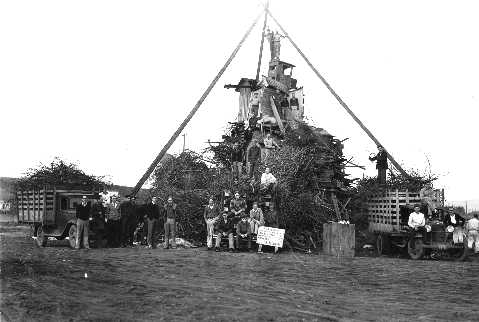Frosh Bonfire
Football fever and school spirit were as much a feature of university life seventy years ago as they are today. Rallies, contests, and bonfires added to the spectacle. The big event, of course, was the then annual game with Idaho's cross-border rival.
Reminiscences and photographs in the library's collections recall that sense of excitement. Among these is Martin Larson's novel Plaster Saint (1953). This novel recalls the author's two years, 1925-1927, as Assistant Professor in the English Department at the University of Idaho. Included is the excitement and drama of the big pep bonfire on the eve of the big game with the nearby state university. It is possible to read Moscow as the town he describes as Belle Ridge in this excerpt:
On this Friday night the great annual bonfire would take place on the slope just east of the Engineering Building. Half the men in the university were engaged in preparing this enterprise. They searched every nook and corner of Belle Ridge for lumber, boards, sticks, tarpaper, corrugated boxes, stumps, logs, coal, oil, gasoline, kerosene - anything, everything, that would make a tremendous blaze. Wagons, carts, automobiles, trucks - every type of conveyance - had been used to transport the fuel. But the pyre would not be constructed until almost the last minute, because no greater victory was conceivable - except winning the great game itself - than that of setting fire prematurely to an opponent's pyre.
Every imaginable sort of stratagem was used to accomplish this purpose. Last year the university had attempted to fire State's pile from an airplane, which dropped flaming torches just before the celebration was to begin. Two years before, a very energetic young man who had been working all day with the students in Belle Ridge, gathering logs, suddenly turned out to be an enemy, who lunged at the pile as it was nearing completion and threw gasoline upon it. As he almost succeeded in firing it, he was pounced upon and severely beaten. This had been a close call.
The novel also offers a very personal view of the university seen through the prism of unhappy recollection. Filled with Jazz Age chicanery, embezzlement, adultery, failed idealism, and the triumph of evil over naivete, Plaster Saint offers a not very attractive picture of the university's inhabitants and habitues.
Is it autobiographical, a reminiscence of a real experience in Moscow? There are many parallels between the novel and the University of Idaho in the 1920s. Not the least is that Larson left teaching to return to Michigan where he sold insurance for several years before opening a paint store. Many of the libertarian ideas his hero espouses in the book are reflected in his service to Americans United for Separation of Church and State in the mid 1960s. He died in Phoenix, Arizona, in 1994, author of a number of political and philosophical works, and one novel.
Caption: University of Idaho freshman bonfire. 1931. Photo by Hodgins. Historical Photograph Collection, University of Idaho Library. #2-102-7c.

 Email Special Collections:
Email Special Collections: Call Special Collections:
Call Special Collections: